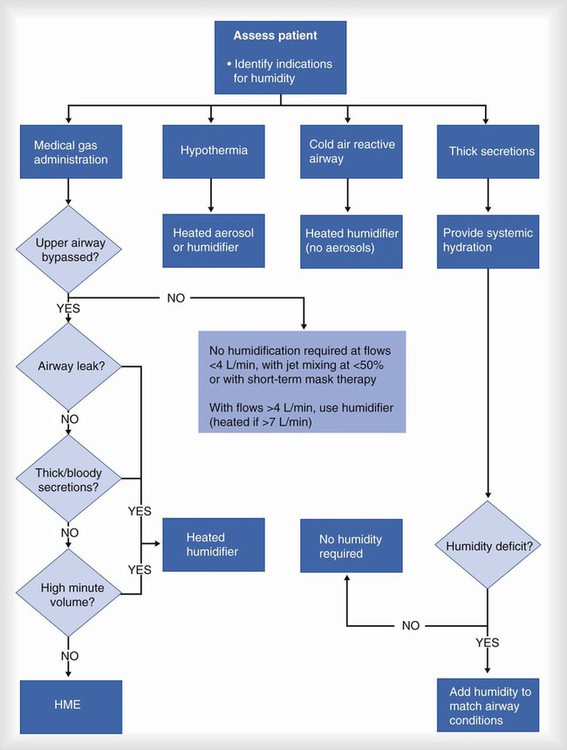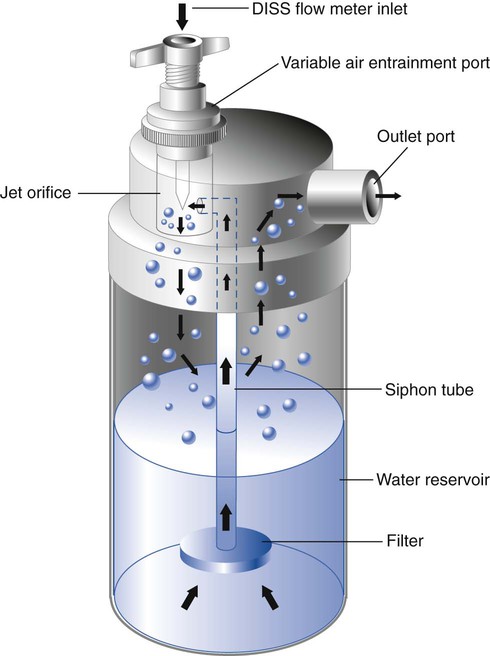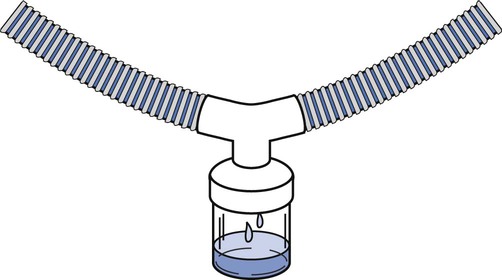1. Identify the goals of humidification and their clinical application. 2. Identify hazards and complications to bland aerosol therapy. 4. Use a large-volume nebulizer. 6. Use humidification during mechanical ventilation. 7. Compare and contrast the indications for heat and humidification versus heat moisture exchange use in the mechanically ventilated patient. The primary function of the upper respiratory tract is to heat and humidify the air we breathe. Clinical signs and symptoms of inadequate airway humidification may be noticed during routine patient assessment or reported by a patient as dryness of the nose or cough (Box 13-1). With numerous devices available, the respiratory therapist (RT) must be knowledgeable about how these devices work to be able to administer therapy to patients in the most appropriate and effective ways. Determination of the most appropriate way to condition a patient’s inspired medical gas requires patient assessment and evaluation of the goal of the therapy. An algorithm to assist in selecting the appropriate humidification delivery device is provided in Figure 13-1. This chapter will cover pertinent information relating to the equipment and clinical applications of humidification and bland aerosol therapy. Use of small-volume nebulizers for medication delivery will be covered in Chapter 19. 1. Review the patient’s chart. 2. Verify the physician’s order or the facility’s protocol for standard of care. 3. Obtain, clean, and inspect appropriate equipment prior to entering the patient’s room. 4. Follow personal protective equipment (PPE) requirements, and observe standard precautions for any transmission-based isolation procedure. 5. Identify the patient using two patient identifiers. 6. Introduce yourself to the patient and to the family. 7. Explain the procedure to the patient and to the family, and acknowledge the patient’s understanding. 8. Perform proper hand hygiene, and put on gloves, mask, and protective eyewear, as appropriate for the procedure. 1. Place the patient in a comfortable position. 3. Assess the need for humidification: 4. Fill the reservoir with sterile water: 5. Attach the humidifier to the flowmeter. 6. Attach the small-bore tubing of the oxygen delivery device to the humidifier: 7. Adjust oxygen to the desired flow. 8. Position the oxygen delivery device on the patient. 9. Ensure that the patient is comfortable with the device. 10. Remove the supplies from the patient’s room, and clean the area, as needed. 11. Remove the PPE, and perform proper hand hygiene prior to leaving the patient’s room. Frequently, in the presence of infection, airway adjunct use, or exacerbation of a respiratory pathology, patients will require bland aerosol therapy. Their secretions may become inspissated, or thickened, because of dehydration. The most common device used to deliver this therapy is a large-volume nebulizer. Images of large volume nebulizers are provided in Figure 13-2. A heater may also be included in the system, if required. When heating inspired gas, a water trap system should be incorporated to trap condensation, the change of state from gas to liquid, also called “rain-out.” Figure 13-3 illustrates a water trap system. Water in the circuit may alter the FiO2 being delivered, is an aspiration risk to the patient, and poses an infection risk to both the patient and the caregiver. The following is the step-by-step process for using a large-volume nebulizer. 1. Review the patient’s chart. 2. Verify the physician’s order or the facility’s protocol for standard of care. 3. Obtain, clean, and inspect appropriate equipment prior to entering the patient’s room. 4. Follow PPE requirements, and observe standard precautions for any transmission-based isolation procedure. 5. Identify the patient using two patient identifiers. 6. Introduce yourself to the patient and to the family. 7. Explain the procedure to the patient and to the family, and acknowledge the patient’s understanding. 8. Perform proper hand hygiene, and put on gloves, mask, and protective eyewear, as appropriate for the procedure. 1. Place the patient in a comfortable position. 3. Assess the need for humidification: 4. Fills the reservoir with sterile water: 5. Attach the humidifier to the flowmeter. 6. Attach the large-bore tubing of the oxygen delivery device to the humidifier: 7. Adjust oxygen to the desired flow and FIO2. 8. Position the oxygen delivery device on the patient. 9. Ensure that the patient is comfortable with the device. 10. Remove the supplies from the patient’s room, and clean the area, as needed.
Humidity and Bland Aerosol Therapy

» Skill Check Lists
13-1 Using a Bubble Humidifier
Procedural Preparation
Implementation
13-2 Using a Large-Volume Nebulizer


Procedural Preparation
Implementation
![]()
Stay updated, free articles. Join our Telegram channel

Full access? Get Clinical Tree






















